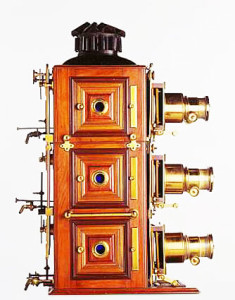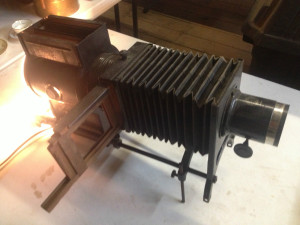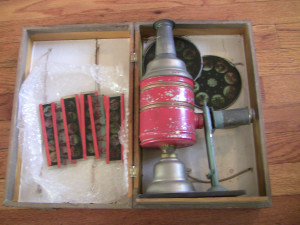The magic lantern was invented in the 1600’s, probably by Christiaan Huygens, a Dutch scientist. It was the earliest form of slide projector and has a long and fascinating history. The first magic lanterns were illuminated by candles, but as technology evolved they were lit by increasingly powerful means.

The name “magic lantern” comes from the experience of the early audiences who saw devils and angels mysteriously appear on the wall, as if by magic. Even in the earliest period, performances contained images that moved—created with moving pieces of glass.
By the 18th century the lantern was a common form of entertainment and education in Europe. The earliest known “lanthorn show” in the U. S. was in Salem, Massachusetts, on December 3, 1743, “for the Entertainment of the Curious.” But the source of light for lanterns in this period—usually oil lamps—was still weak, and as a consequence the audiences were small.
In the mid 19th century, two new forms of illumination were developed which led to an explosion of lantern use. “Limelight” was created by heating a piece of limestone in burning gas until it became incandescent. It was dangerous, but produced a light that was strong enough to project an image before thousands of people, leading to large shows by professional showmen. Kerosene lamps were not nearly as bright, but they were so safe they could be used by children, leading to wide-spread use in churches, schools, fraternal societies, and in toy lanterns. By the turn to the 20th century, electric illumination was introduced, which spread the lantern even further.
 Lanterns became ubiquitous in American culture. Several hundred companies made their own brands, often in a bewildering array of different models. At the top end were the exotic “triunials” and “biunials” which were three and two-lens lanterns used by professional showmen. At the bottom were inexpensive single lens lanterns, and the very popular children’s lanterns which were a favorite Christmas present. As yet there is no published description covering all these different kinds of lanterns.
Lanterns became ubiquitous in American culture. Several hundred companies made their own brands, often in a bewildering array of different models. At the top end were the exotic “triunials” and “biunials” which were three and two-lens lanterns used by professional showmen. At the bottom were inexpensive single lens lanterns, and the very popular children’s lanterns which were a favorite Christmas present. As yet there is no published description covering all these different kinds of lanterns.
While the triunials and biunials can be expensive, a good working lantern, big enough to handle the standard large-format slides, can be found on eBay, with careful searching, for under $100, and a basic working children’s lantern for under $50.
large-format slides, can be found on eBay, with careful searching, for under $100, and a basic working children’s lantern for under $50.  Thus it is easy to begin a magic-lantern collection, and to create shows using the slides that are also readily and inexpensively available on eBay. Just search for “magic lantern.”
Thus it is easy to begin a magic-lantern collection, and to create shows using the slides that are also readily and inexpensively available on eBay. Just search for “magic lantern.”